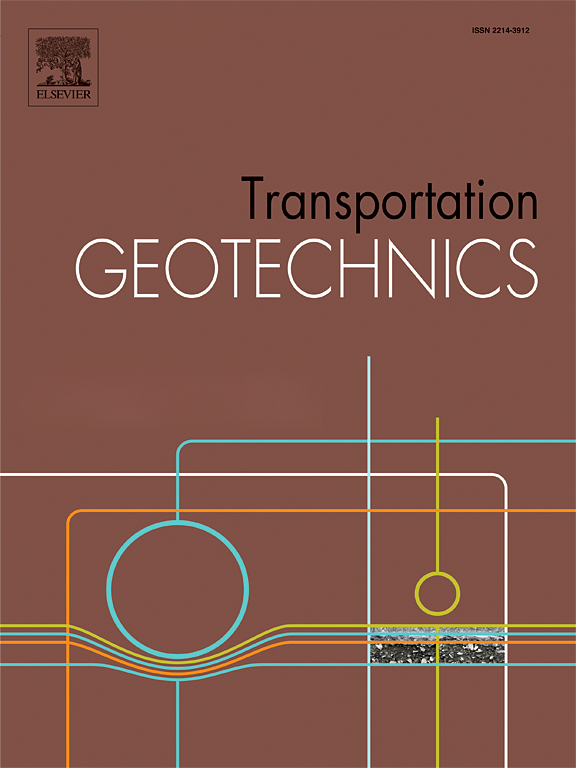Seismic stability analysis of anchored concave slopes
IF 4.9
2区 工程技术
Q1 ENGINEERING, CIVIL
引用次数: 0
Abstract
Concave-facing profiles are frequently encountered in natural slopes and, more recently, in man-made slopes. The seismic stability of such concave slopes can be effectively improved by employing ground anchors. The concavity of the slope profile can be effective in the design of the soil anchoring system. Using the pseudo-static limit equilibrium (LE) approach and considering a rotational log-spiral failure mechanism, this paper analytically addresses the total anchor load required for the stability of concave soil slopes reinforced with pre-tensioned cable anchors under seismic loading conditions. The concave face of the slope is represented by a circular arc, the curvature of which is expressed by the mid-chord offset (MCO) parameter. A satisfactory agreement was found between the results predicted by the solution and those of the finite element method. The impact of profile concavity on the resulting total anchor load was explored by varying backslope inclination, vertical-to-horizontal seismic coefficient ratio, and the action point of the total anchor load. Further, a design example is presented to illustrate how the load of anchors for a given anchorage layout can be determined using the method. The results generally indicate that a concave slope requires less total anchor load to provide seismic stability compared to an equivalent planar one. However, the concavity impact decreases with increasing horizontal seismic coefficient and backslope inclination. Further, the direction of the vertical seismic coefficient was found to be effective on the impact of concavity.
锚固凹坡地震稳定性分析
面对凹形的剖面在天然斜坡中经常遇到,最近在人造斜坡中也经常遇到。采用地锚可以有效地提高此类凹坡的地震稳定性。边坡轮廓的凹凸度可以有效地用于土体锚固系统的设计。本文采用拟静力极限平衡方法,考虑旋转对数螺旋破坏机制,对地震荷载条件下预应力锚索加固凹土边坡稳定所需的总锚杆荷载进行了解析求解。斜坡的凹面用圆弧表示,圆弧的曲率用中弦偏移量(MCO)参数表示。计算结果与有限元计算结果吻合较好。通过改变后坡倾角、纵横地震系数比和总锚杆荷载作用点,探讨了剖面凹凸度对总锚杆荷载的影响。此外,还给出了一个设计实例来说明如何使用该方法确定给定锚固布置的锚杆载荷。结果普遍表明,与同等平面边坡相比,凹形边坡提供地震稳定性所需的总锚杆荷载较少。而随着水平地震系数的增大和反坡倾角的增大,凹度的影响减小。此外,竖向地震系数的方向对凹凸度的影响是有效的。
本文章由计算机程序翻译,如有差异,请以英文原文为准。
求助全文
约1分钟内获得全文
求助全文
来源期刊

Transportation Geotechnics
Social Sciences-Transportation
CiteScore
8.10
自引率
11.30%
发文量
194
审稿时长
51 days
期刊介绍:
Transportation Geotechnics is a journal dedicated to publishing high-quality, theoretical, and applied papers that cover all facets of geotechnics for transportation infrastructure such as roads, highways, railways, underground railways, airfields, and waterways. The journal places a special emphasis on case studies that present original work relevant to the sustainable construction of transportation infrastructure. The scope of topics it addresses includes the geotechnical properties of geomaterials for sustainable and rational design and construction, the behavior of compacted and stabilized geomaterials, the use of geosynthetics and reinforcement in constructed layers and interlayers, ground improvement and slope stability for transportation infrastructures, compaction technology and management, maintenance technology, the impact of climate, embankments for highways and high-speed trains, transition zones, dredging, underwater geotechnics for infrastructure purposes, and the modeling of multi-layered structures and supporting ground under dynamic and repeated loads.
 求助内容:
求助内容: 应助结果提醒方式:
应助结果提醒方式:


